Quantifying the Variability of Forest Ecosystem Vulnerability in the Largest Water Tower Region Globally
Abstract
:1. Introduction
- (1)
- Detect where and during which time periods forests are likely becoming increasingly vulnerable to natural context stress, environmental disturbances, and socioeconomic impacts.
- (2)
- Map forest vulnerability across the QTP region and delimit the degree of protection required in different areas based on the FVI.
- (3)
- Understand the behavior of the vulnerability relative to its driving factors.
2. Materials and Methods
2.1. Study Site
2.2. Data Collection and Processing
2.3. Framework of Index System for Forest Vulnerability Evaluation
2.4. Operation of Indices and Factors
2.5. Method for Determining Ecological Protection-Oriented and Vulnerability-Based Spatial Pattern of Forest Protection
3. Results
3.1. Spatiotemporal Characteristics of Forest Vulnerability Relevant to Natural and Human Factors
3.2. Comprehensive Forest Vulnerability in the QTP
3.3. Heterogeneity of Forest Vulnerability under Different Terrains
3.4. Ecological Protection-Oriented Spatial Pattern of Forest Vulnerability
3.4.1. Strict Protection Region
3.4.2. Focal Protection Region
3.4.3. Composite Protection Region
4. Discussion
4.1. Drivers of Forest Vulnerability Change
4.2. Management Implications for Forest Ecosystem Management in Large Water Tower Regions
5. Conclusions
Author Contributions
Funding
Institutional Review Board Statement
Informed Consent Statement
Data Availability Statement
Conflicts of Interest
References
- Köhl, M.; Lasco, R.; Cifuentes, M.; Jonsson, Ö; Korhonen, K.T.; Mundhenk, P.; Navar, J.D.J.; Stinson, G. Changes in forest production, biomass and carbon: Results from the 2015 UN FAO Global Forest Resource Assessment. For. Ecol. Manag. 2015, 352, 21–34. [Google Scholar] [CrossRef] [Green Version]
- Patterson, T.M.; Coelho, D.L. Ecosystem services: Foundations, opportunities, and challenges for the forest products sector. For. Ecol. Manag. 2009, 257, 1637–1646. [Google Scholar] [CrossRef]
- Özcan, O.; Musaoglu, N.; Türkeş, M. Assessing vulnerability of a forest ecosystem to climate change and variability in the western Mediterranean sub-region of Turkey. J. For. Res. 2018, 29, 709–725. [Google Scholar] [CrossRef]
- Gerlitz, J.-Y.; Macchi, M.; Brooks, N.; Pandey, R.; Banerjee, S.; Jha, S.K. The Multidimensional Livelihood Vulnerability Index—An instrument to measure livelihood vulnerability to change in the Hindu Kush Himalayas. Clim. Dev. 2017, 9, 124–140. [Google Scholar] [CrossRef]
- Sharma, J.; Upgupta, S.; Jayaraman, M.; Chaturvedi, R.K.; Bala, G.; Ravindranath, N.H. Vulnerability of Forests in India: A National Scale Assessment. Environ. Manag. 2017, 60, 544–553. [Google Scholar] [CrossRef] [PubMed]
- Xu, X.; Lu, C.; Shi, X.; Gao, S. World water tower: An atmospheric perspective. Geophys. Res. Lett. 2008, 35, 35. [Google Scholar] [CrossRef]
- Immerzeel, W.W.; Lutz, A.F.; Andrade, M.; Bahl, A.; Biemans, H.; Bolch, T.; Hyde, S.; Brumby, S.; Davies, B.; Elmore, A.C.; et al. Importance and vulnerability of the world’s water towers. Nat. Cell Biol. 2020, 577, 364–369. [Google Scholar] [CrossRef] [PubMed]
- Guo, B.; Han, B.; Yang, F.; Chen, S.; Liu, Y.; Yang, W. Determining the contributions of climate change and human activities to the vegetation NPP dynamics in the Qinghai-Tibet Plateau, China, from 2000 to 2015. Environ. Monit. Assess. 2020, 192, 1–18. [Google Scholar] [CrossRef] [PubMed]
- Hosonuma, N.; Herold, M.; De Sy, V.; De Fries, R.S.; Brockhaus, M.; Verchot, L.; Angelsen, A.; Romijn, E. An assessment of deforestation and forest degradation drivers in developing countries. Environ. Res. Lett. 2012, 7, 7. [Google Scholar] [CrossRef]
- Echeverria, C.; Coomes, D.A.; Hall, M.; Newton, A.C. Spatially explicit models to analyze forest loss and fragmentation between 1976 and 2020 in southern Chile. Ecol. Model. 2008, 212, 439–449. [Google Scholar] [CrossRef]
- Li, Q.; Zhang, C.; Shen, Y.; Jia, W.; Li, J. Quantitative assessment of the relative roles of climate change and human activities in desertification processes on the Qinghai-Tibet Plateau based on net primary productivity. Catena 2016, 147, 789–796. [Google Scholar] [CrossRef]
- Guo, B.; Zang, W.; Yang, F.; Han, B.; Chen, S.; Liu, Y.; Yang, X.; He, T.; Chen, X.; Liu, C.; et al. Spatial and temporal change patterns of net primary productivity and its response to climate change in the Qinghai-Tibet Plateau of China from 2000 to 2015. J. Arid. Land 2019, 12, 1–17. [Google Scholar] [CrossRef] [Green Version]
- Sekhri, S.; Kumar, P.; Fürst, C.; Pandey, R. Mountain specific multi-hazard risk management framework (MSMRMF): Assessment and mitigation of multi-hazard and climate change risk in the Indian Himalayan Region. Ecol. Indic. 2020, 118, 106700. [Google Scholar] [CrossRef]
- Kirschbaum, D.; Kapnick, S.B.; Stanley, T.; Pascale, S. Changes in Extreme Precipitation and Landslides Over High Mountain Asia. Geophys. Res. Lett. 2020, 47, 47. [Google Scholar] [CrossRef]
- Kumar, M.; Savita; Singh, H.; Pandey, R.; Singh, M.P.; Ravindranath, N.H.; Kalra, N. Assessing vulnerability of forest ecosystem in the Indian Western Himalayan region using trends of net primary productivity. Biodivers. Conserv. 2019, 28, 2163–2182. [Google Scholar] [CrossRef] [Green Version]
- Thakur, S.; Negi, V.S.; Pathak, R.; Dhyani, R.; Durgapal, K.; Rawal, R.S. Indicator based integrated vulnerability assessment of community forests in Indian west Himalaya. For. Ecol. Manag. 2020, 457, 117674. [Google Scholar] [CrossRef]
- Liu, D.; Cao, C.; Dubovyk, O.; Tian, R.; Chen, W.; Zhuang, Q.; Zhao, Y.; Menz, G. Using fuzzy analytic hierarchy process for spatio-temporal analysis of eco-environmental vulnerability change during 1990–2010 in Sanjiangyuan region, China. Ecol. Indic. 2017, 73, 612–625. [Google Scholar] [CrossRef]
- Yang, W.; Xu, K.; Lian, J.; Bin, L.; Ma, C. Multiple flood vulnerability assessment approach based on fuzzy comprehensive evaluation method and coordinated development degree model. J. Environ. Manag. 2018, 213, 440–450. [Google Scholar] [CrossRef] [PubMed]
- Sahoo, S.; Dhar, A.; Kar, A. Environmental vulnerability assessment using Grey Analytic Hierarchy Process based model. Environ. Impact Assess. Rev. 2016, 56, 145–154. [Google Scholar] [CrossRef]
- Sheikhian, H.; Delavar, M.R.; Stein, A. A GIS-based multi-criteria seismic vulnerability assessment using the integration of granular computing rule extraction and artificial neural networks. Trans. GIS 2017, 21, 1237–1259. [Google Scholar] [CrossRef]
- Wang, X.; Zhong, X.; Liu, S.; Liu, J.; Wang, Z.; Li, M. Regional assessment of environmental vulnerability in the Tibetan Plateau: Development and application of a new method. J. Arid. Environ. 2008, 72, 1929–1939. [Google Scholar] [CrossRef]
- Nandy, S.; Singh, C.; Das, K.; Kingma, N.; Kushwaha, S. Environmental vulnerability assessment of eco-development zone of Great Himalayan National Park, Himachal Pradesh, India. Ecol. Indic. 2015, 57, 182–195. [Google Scholar] [CrossRef]
- Wei, W.; Shi, S.; Zhang, X.; Zhou, L.; Xie, B.; Zhou, J.; Li, C. Regional-scale assessment of environmental vulnerability in an arid inland basin. Ecol. Indic. 2020, 109, 105792. [Google Scholar] [CrossRef]
- Zou, T.; Yoshino, K. Environmental vulnerability evaluation using a spatial principal components approach in the Daxing’anling region, China. Ecol. Indic. 2017, 78, 405–415. [Google Scholar] [CrossRef]
- Zhang, X.; Wang, J.; Gao, Y.; Wang, L. Variations and controlling factors of vegetation dynamics on the Qingzang Plateau of China over the recent 20 years. Geogr. Sustain. 2021, 2, 74–85. [Google Scholar] [CrossRef]
- Phinzi, K.; Ngetar, N.S. The assessment of water-borne erosion at catchment level using GIS-based RUSLE and remote sensing: A review. Int. Soil Water Conserv. Res. 2019, 7, 27–46. [Google Scholar] [CrossRef]
- Dikshit, A.; Sarkar, R.; Pradhan, B.; Acharya, S.; Alamri, A.M. Spatial Landslide Risk Assessment at Phuentsholing, Bhutan. Geosci. 2020, 10, 131. [Google Scholar] [CrossRef] [Green Version]
- Manners, R.; Varela-Ortega, C. Analysing Latin American and Caribbean forest vulnerability from socio-economic factors. J. Integr. Environ. Sci. 2017, 14, 109–130. [Google Scholar] [CrossRef] [Green Version]
- Wang, X.; Chu, B.; Feng, X.; Li, Y.; Fu, B.; Liu, S.; Jin, J. Spatiotemporal variation and driving factors of water yield services on the Qingzang Plateau. Geogr. Sustain. 2021, 2, 31–39. [Google Scholar] [CrossRef]
- Ren, W.; Banger, K.; Tao, B.; Yang, J.; Huang, Y.; Tian, H. Global pattern and change of cropland soil organic carbon during 1901-2010: Roles of climate, atmospheric chemistry, land use and management. Geogr. Sustain. 2020, 1, 59–69. [Google Scholar] [CrossRef]
- Chen, A.; Tang, R.; Mao, J.; Yue, C.; Li, X.; Gao, M.; Shi, X.; Jin, M.; Ricciuto, D.; Rabin, S.; et al. Spatiotemporal dynamics of ecosystem fires and biomass burning-induced carbon emissions in China over the past two decades. Geogr. Sustain. 2020, 1, 47–58. [Google Scholar] [CrossRef]
- Ainong, L.; Angsheng, W.; Xiaorong, H.; Wenlan, F.; Wancun, Z. Integrated Evaluation Model for Eco-Environmental Quality in Mountainous Region Based on Remote Sensing and GIS. Wuhan Univ. J. Nat. Sci. 2006, 11, 969–976. [Google Scholar] [CrossRef]
- Li, A.; Wang, A.; Liang, S.; Zhou, W. Eco-environmental vulnerability evaluation in mountainous region using remote sensing and GIS—A case study in the upper reaches of Minjiang River, China. Ecol. Model. 2006, 192, 175–187. [Google Scholar] [CrossRef]
- Hyandye, C.; Tao, W.; Hua, C.Z. Evaluation of eco-environmental vulnerability using RS and GIS: Case of Ma Keng iron mining area in Fu Jian Province, China. Environ. Res. J. 2008, 2, 196–204. [Google Scholar]
- Sam, K.; Chakma, N. Vulnerability profiles of forested landscape to climate change in Bengal Duars region, India. Environ. Earth Sci. 2018, 77, 459. [Google Scholar] [CrossRef]
- Naeem, S.; Zhang, Y.; Tian, J.; Qamer, F.M.; Latif, A.; Paul, P.K. Quantifying the Impacts of Anthropogenic Activities and Climate Variations on Vegetation Productivity Changes in China from 1985 to 2015. Remote Sens. 2020, 12, 1113. [Google Scholar] [CrossRef] [Green Version]
- Jiang, C.; Zhang, L. Effect of ecological restoration and climate change on ecosystems: A case study in the Three-Rivers Headwater Region, China. Environ. Monit. Assess. 2016, 188, 1–20. [Google Scholar] [CrossRef]
- He, Q.; Dai, X.; Chen, S. Assessing the effects of vegetation and precipitation on soil erosion in the Three-River Headwaters Region of the Qinghai-Tibet Plateau, China. J. Arid. Land 2020, 12, 865–886. [Google Scholar] [CrossRef]
- Di, B.; Zhang, H.; Liu, Y.; Li, J.; Chen, N.; Stamatopoulos, C.A.; Luo, Y.; Zhan, Y. Assessing Susceptibility of Debris Flow in Southwest China Using Gradient Boosting Machine. Sci. Rep. 2019, 9, 1–12. [Google Scholar] [CrossRef] [Green Version]
- Chen, L.; Mei, L.; Zeng, B.; Yin, K.; Shrestha, D.P.; Du, J. Failure probability assessment of landslides triggered by earthquakes and rainfall: A case study in Yadong County, Tibet, China. Sci. Rep. 2020, 10, 1–12. [Google Scholar] [CrossRef]
- Referowska-Chodak, E. Pressures and Threats to Nature Related to Human Activities in European Urban and Suburban Forests. Forests 2019, 10, 765. [Google Scholar] [CrossRef] [Green Version]
- Dutta, S.; Sahana, M.; Guchhait, S.K. Assessing anthropogenic disturbance on forest health based on fragment grading in Durgapur Forest Range, West Bengal, India. Spat. Inf. Res. 2017, 25, 501–512. [Google Scholar] [CrossRef]
- Wang, D.; Jia, X.; Liu, F.; Dai, Q. Evaluation of highway construction impact on ecological environment of Qinghai-Tibet Plateau. Environ. Eng. Manag. J. 2020, 19, 1157–1166. [Google Scholar] [CrossRef]
- Yin, C.; Zhang, J. Hazard regionalization of debris-flow disasters along highways in China. Nat. Hazards 2018, 91, 129–147. [Google Scholar] [CrossRef]
- Luo, L.; Duan, Q.; Wang, L.; Zhao, W.; Zhuang, Y. Increased human pressures on the alpine ecosystem along the Qinghai-Tibet Railway. Reg. Environ. Chang. 2020, 20, 1–13. [Google Scholar] [CrossRef]
- Qiu, P.; Zhou, Z.; Kim, D.J. Review of Forest Ecosystem Management. Ecol. Econ. 2017, 33, 195–201. [Google Scholar]
- Wan, J.-Z.; Wang, C.-J.; Qu, H.; Liu, R.; Zhang, Z.-X. Vulnerability of forest vegetation to anthropogenic climate change in China. Sci. Total Environ. 2018, 621, 1633–1641. [Google Scholar] [CrossRef]
- Wang, H.; Liu, G.; Li, Z.; Wang, P.; Wang, Z. Comparative Assessment of Vegetation Dynamics under the Influence of Climate Change and Human Activities in Five Ecologically Vulnerable Regions of China from 2000 to 2015. Forests 2019, 10, 317. [Google Scholar] [CrossRef] [Green Version]
- Trumbore, S.E.; Brando, P.M.; Hartmann, H. Forest health and global change. Science 2015, 349, 814–818. [Google Scholar] [CrossRef] [Green Version]
- Cinco-Castro, S.; Herrera-Silveira, J. Vulnerability of mangrove ecosystems to climate change effects: The case of the Yucatan Peninsula. Ocean Coast. Manag. 2020, 192, 105196. [Google Scholar] [CrossRef]
- Wu, S.; Zhou, W.; Yan, K.; Zhang, X. Response of the Water Conservation Function to Vegetation Dynamics in the Qinghai & x2013;Tibetan Plateau Based on MODIS Products. IEEE J. Sel. Top. Appl. Earth Obs. Remote Sens. 2020, 13, 1675–1686. [Google Scholar]
- Scheller, R.M.; Parajuli, R. Forest Management for Climate Change in New England and the Klamath Ecoregions: Motivations, Practices, and Barriers. Forests 2018, 9, 626. [Google Scholar] [CrossRef] [Green Version]
- Qi, X.; Jia, J.; Liu, H.; Lin, Z. Relative importance of climate change and human activities for vegetation changes on China’s silk road economic belt over multiple timescales. Catena 2019, 180, 224–237. [Google Scholar] [CrossRef]
- Williamson, T.B.; Johnston, M.H.; Nelson, H.W.; Edwards, J.E. Adapting to climate change in Canadian forest management: Past, present and future. For. Chron. 2019, 95, 76–90. [Google Scholar] [CrossRef]
- Svirchev, L.; Li, Y.; Yan, L.; Ma, B.; He, C. Preventing and limiting exposure to geo-hazards: Some lessons from two mountain villages destroyed by the Wenchuan earthquake. J. Mt. Sci. 2011, 8, 190–199. [Google Scholar] [CrossRef]
- Fan, F.; Liu, Y.; Chen, J.; Dong, J. Scenario-based ecological security patterns to indicate landscape sustainability: A case study on the Qinghai-Tibet Plateau. Landsc. Ecol. 2021, 36, 2175–2188. [Google Scholar] [CrossRef]
- Zhou, Y.; Fu, D.; Lu, C.; Xu, X.; Tang, Q. Positive effects of ecological restoration policies on the vegetation dynamics in a typical ecologically vulnerable area of China. Ecol. Eng. 2021, 159, 106087. [Google Scholar] [CrossRef]
- Sharma, J.; Chaturvedi, R.K.; Bala, G.; Ravindranath, N. Challenges in vulnerability assessment of forests under climate change. Carbon Manag. 2013, 4, 403–411. [Google Scholar] [CrossRef]
- Timberlake, T.J.; Schultz, C.A. Climate Change Vulnerability Assessment for Forest Management: The Case of the U.S. Forest Service. Forests 2019, 10, 1030. [Google Scholar] [CrossRef] [Green Version]
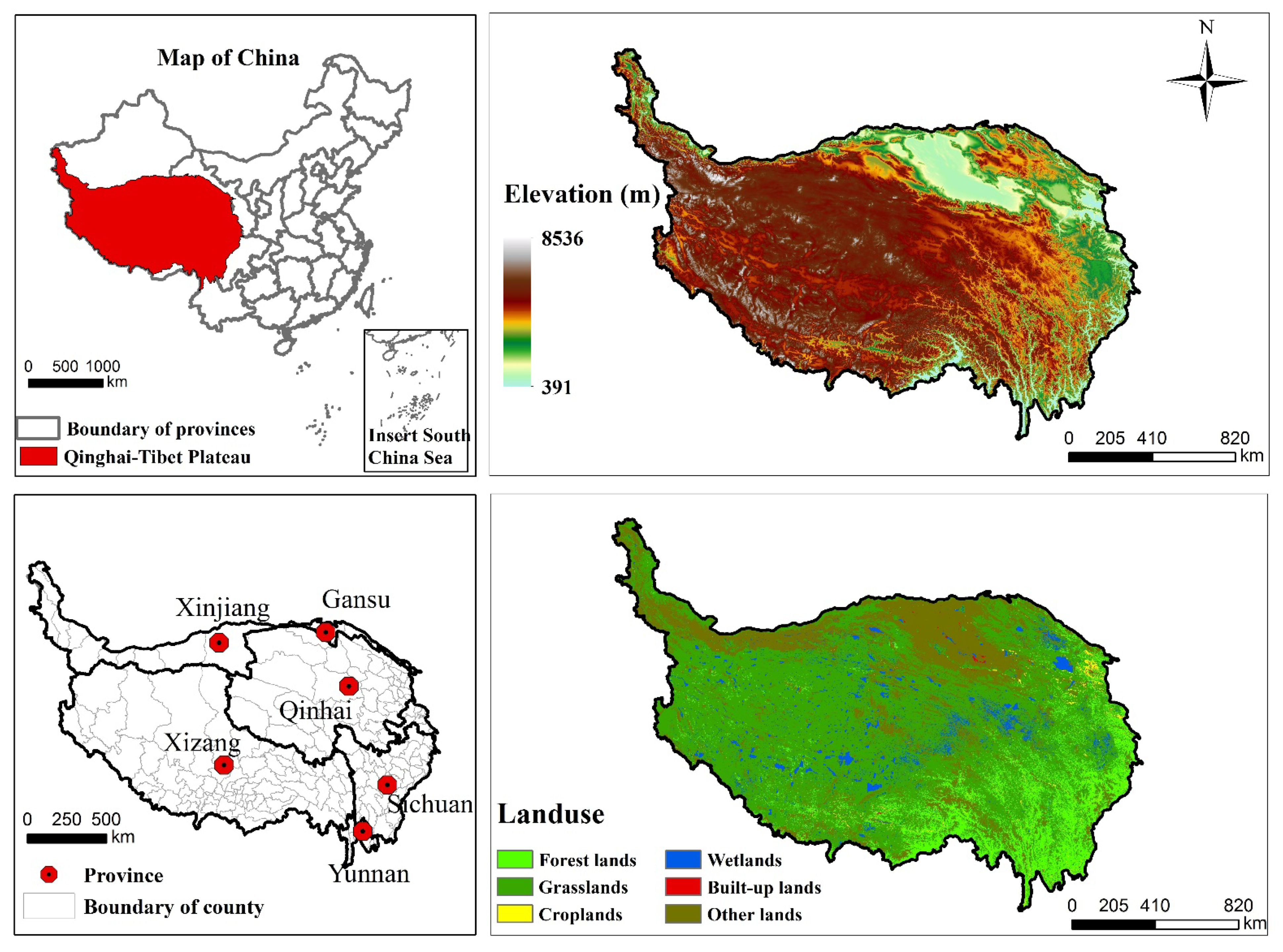
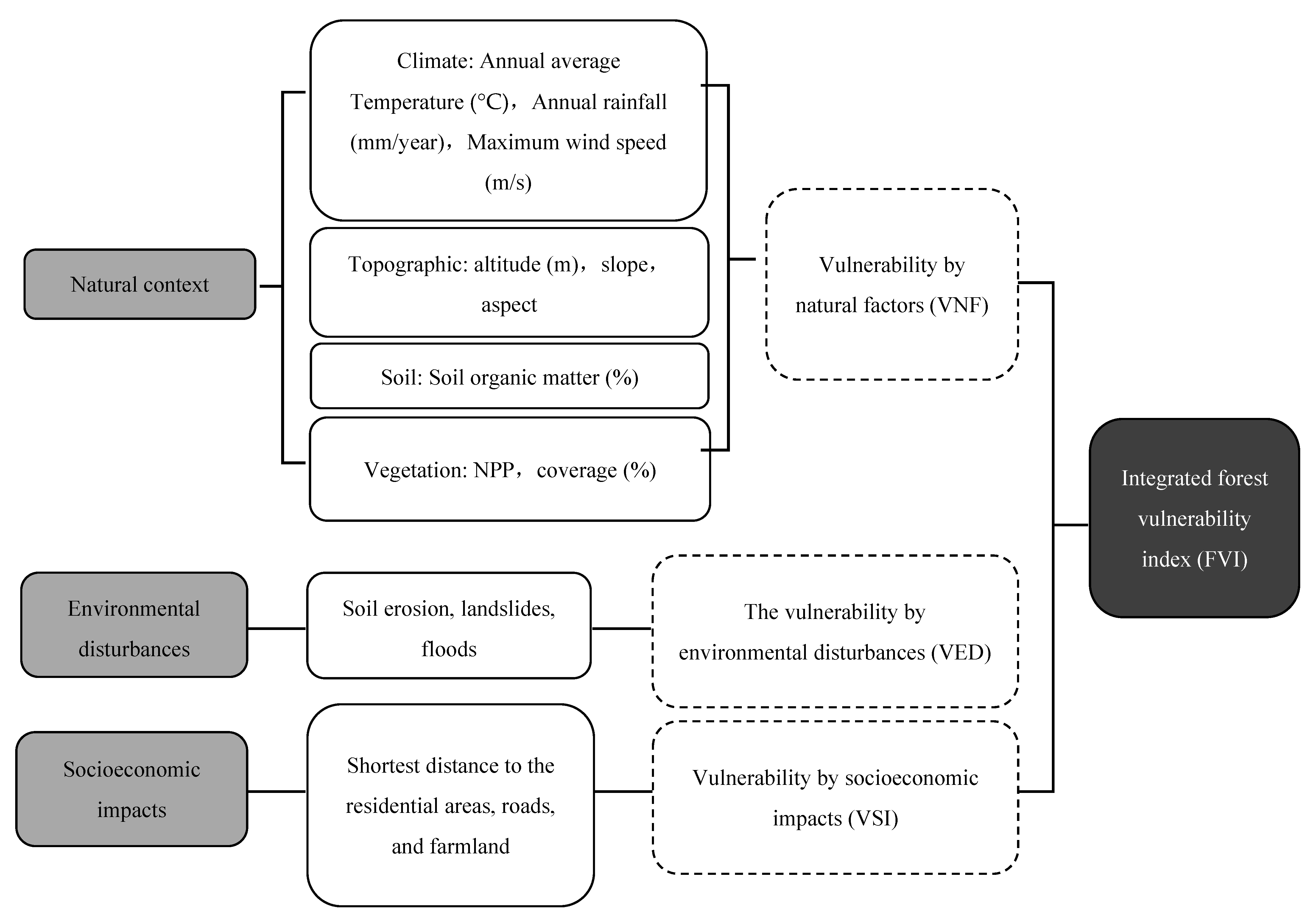
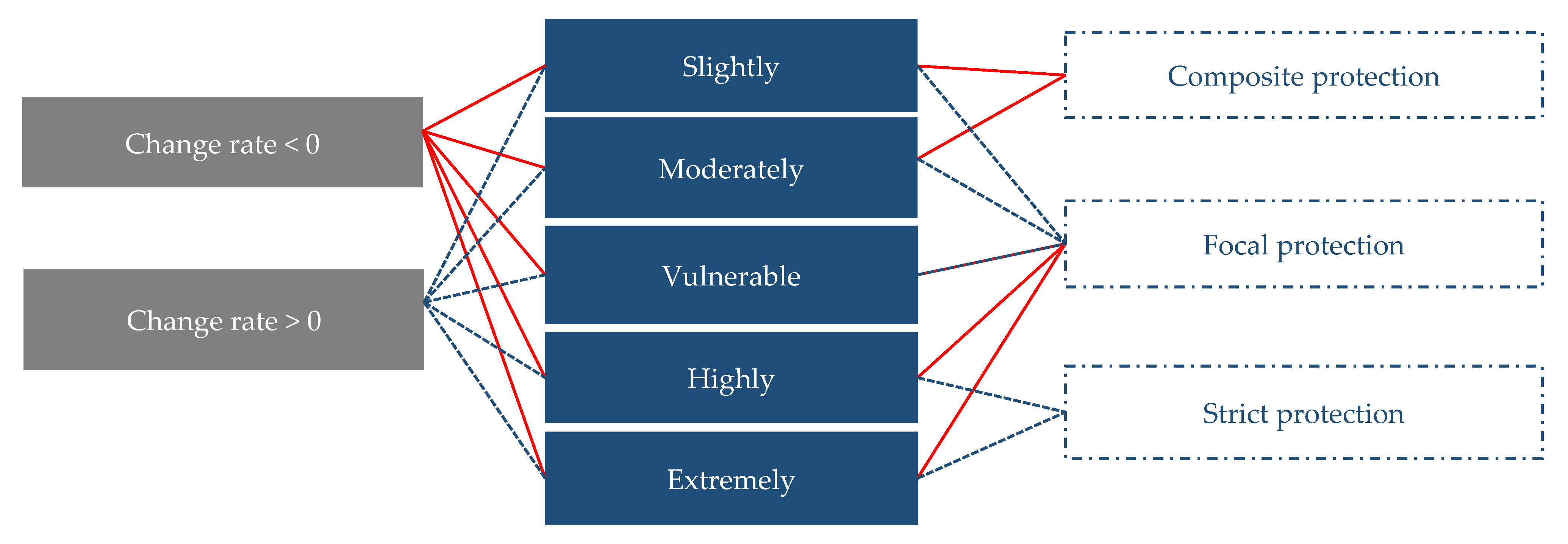
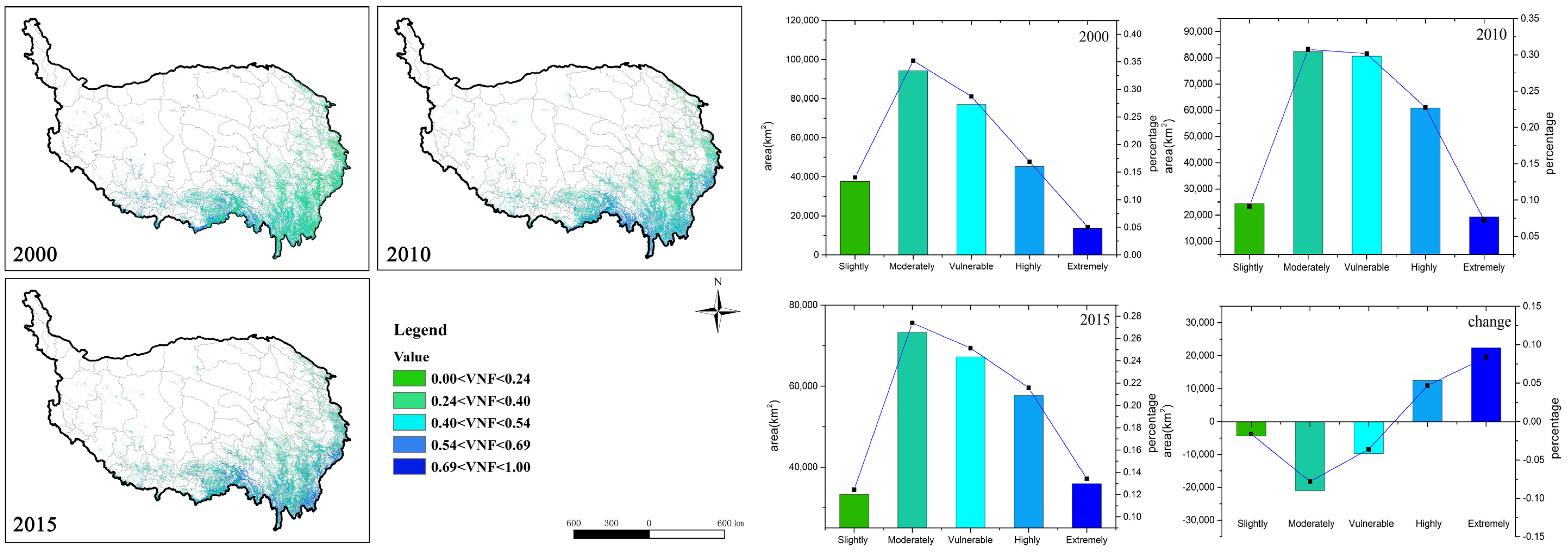
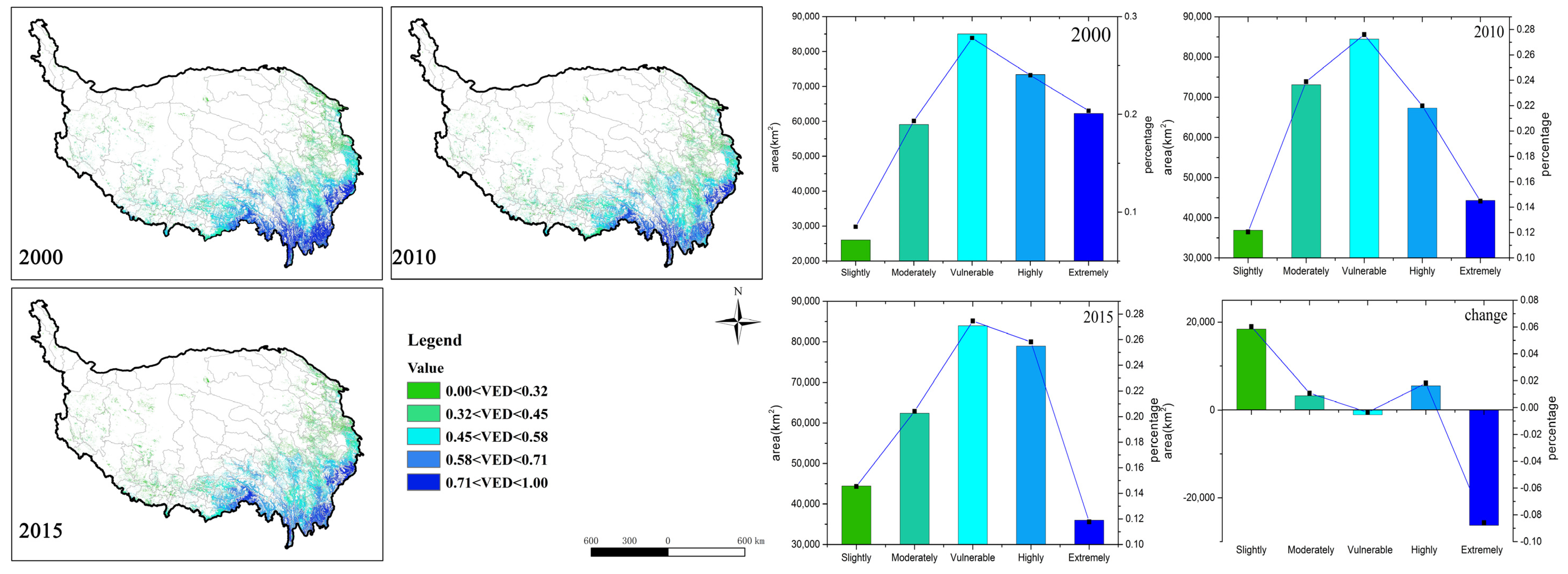

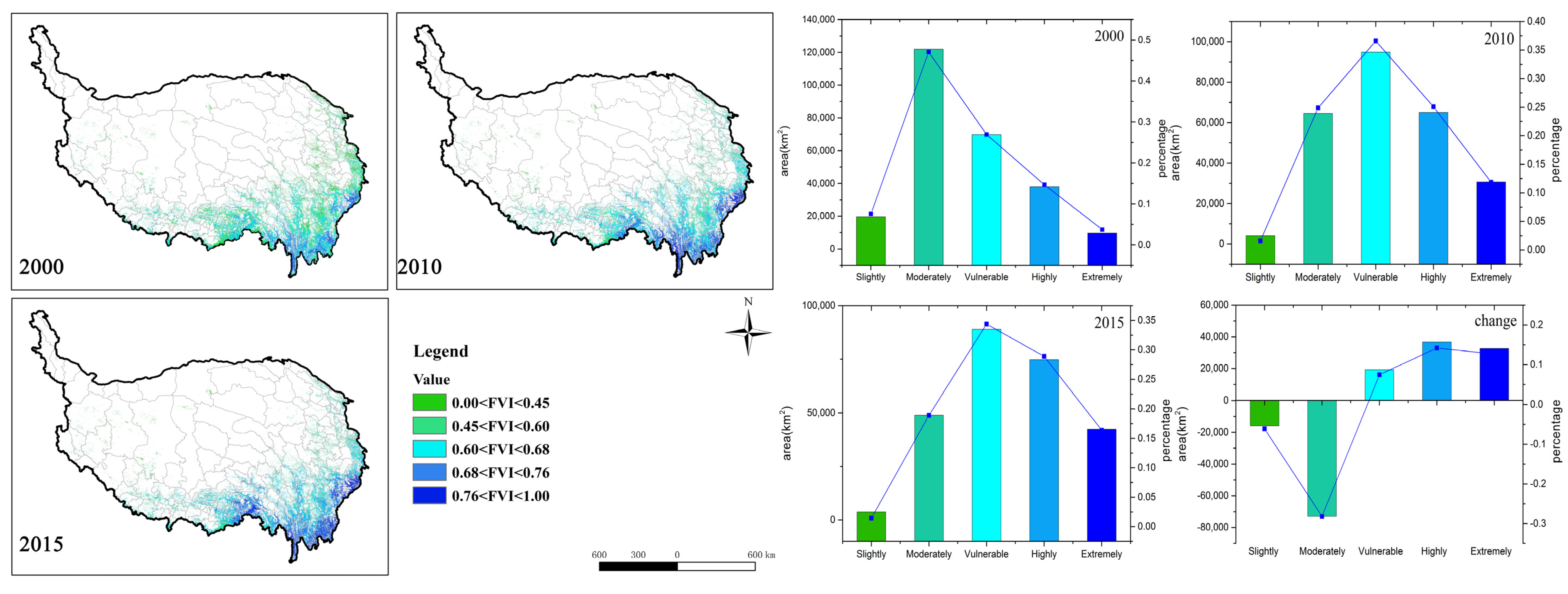

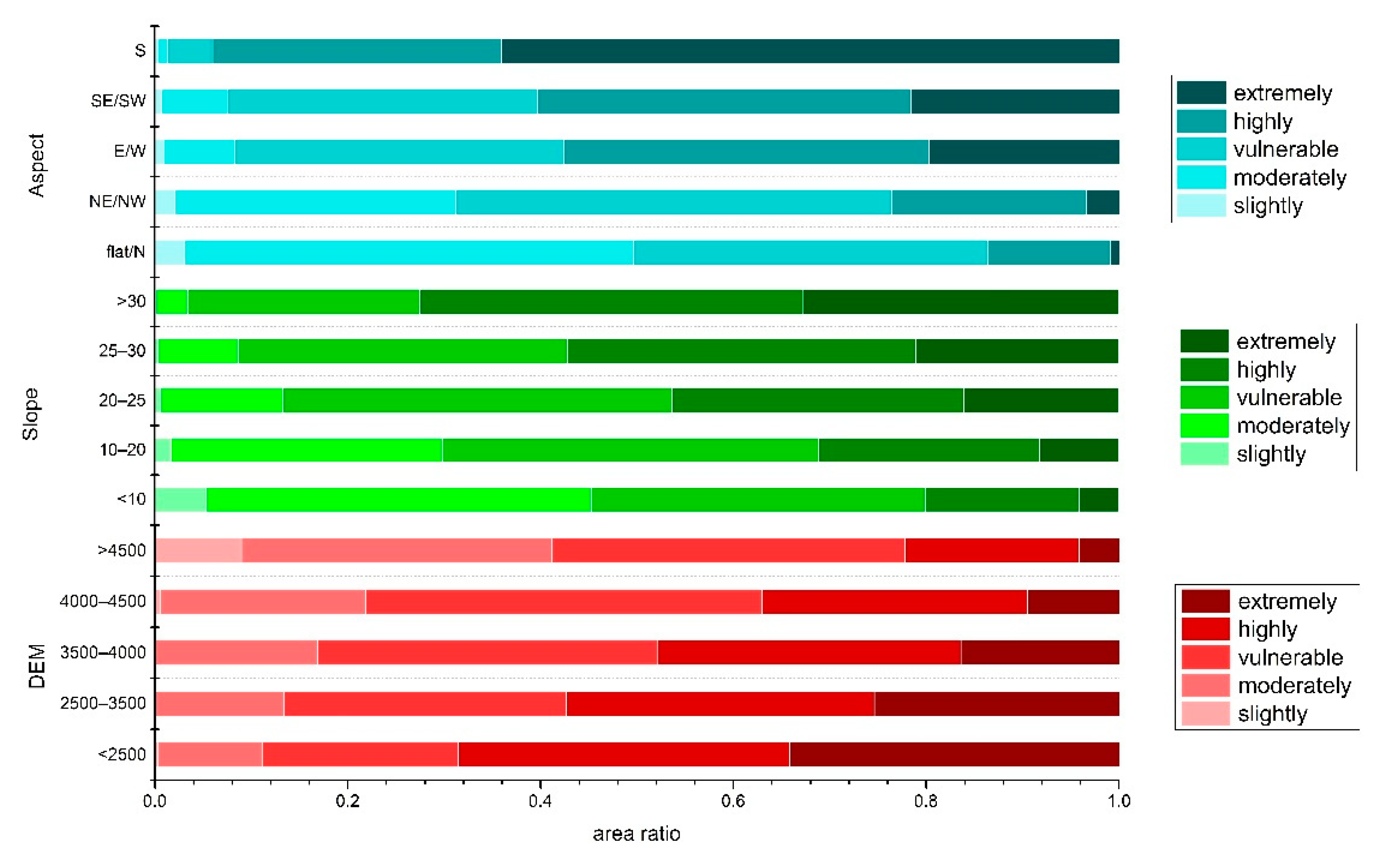
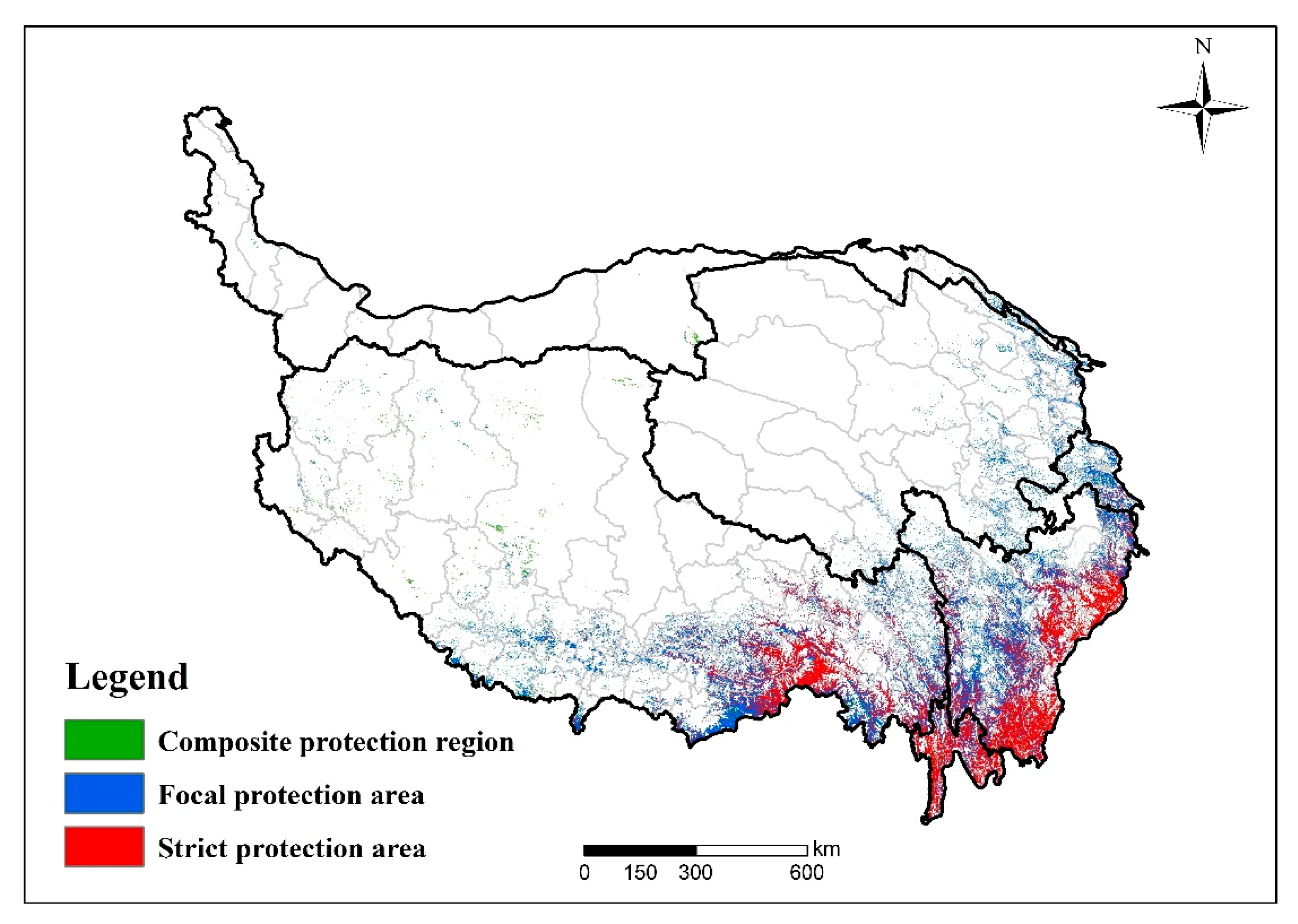
| PC Layers | Eigenvalue | ||||||||
|---|---|---|---|---|---|---|---|---|---|
| VNF | VED | VSI | |||||||
| 2000 | 2010 | 2015 | 2000 | 2010 | 2015 | 2000 | 2010 | 2015 | |
| 1 | 0.58 | 0.57 | 0.61 | 0.27 | 0.26 | 0.26 | 0.11 | 0.08 | 0.08 |
| 2 | 0.55 | 0.52 | 0.49 | 0.05 | 0.06 | 0.05 | 0.06 | 0.05 | 0.05 |
| 3 | 0.23 | 0.34 | 0.27 | 0.00 | 0.00 | 0.00 | 0.02 | 0.03 | 0.03 |
| 4 | 0.17 | 0.12 | 0.12 | ||||||
| 5 | 0.11 | 0.10 | 0.12 | ||||||
| 6 | 0.11 | 0.07 | 0.11 | ||||||
| 7 | 0.07 | 0.05 | 0.06 | ||||||
| 8 | 0.03 | 0.04 | 0.04 | ||||||
| 9 | 0.03 | 0.03 | 0.03 | ||||||
| Factors | Principal Components | Contribution (%) | ||||||||
|---|---|---|---|---|---|---|---|---|---|---|
| Ⅰ | Ⅱ | Ⅲ | Ⅳ | Ⅴ | Ⅵ | Ⅶ | Ⅷ | Ⅸ | ||
| Eigenvalue (10−2) | ||||||||||
| 0.61 | 0.49 | 0.27 | 0.12 | 0.12 | 0.11 | 0.06 | 0.04 | 0.03 | ||
| Eigenvectors | ||||||||||
| ASPECT | 0.6923 | 0.7187 | −0.0633 | 0.0096 | −0.0066 | 0.0052 | −0.0033 | 0.0022 | −0.0035 | 52.66 |
| FOREST COVERAGE | −0.4490 | 0.4777 | 0.5256 | 0.1596 | 0.1937 | −0.1169 | −0.4172 | −0.1976 | −0.0643 | 7.15 |
| SOIL OGANIC MATTER | −0.0718 | 0.0828 | 0.0806 | 0.2447 | 0.1338 | −0.7345 | 0.5773 | 0.0696 | 0.1618 | 1.94 |
| TEMPERATURE | 0.2145 | −0.1770 | 0.4096 | 0.1977 | 0.0303 | −0.0275 | −0.1588 | 0.7939 | −0.2424 | 13.27 |
| WIND SPEED | −0.2585 | 0.1873 | −0.6645 | 0.3378 | 0.4556 | 0.0578 | −0.1115 | 0.2652 | −0.2209 | −10.13 |
| PERCIPITATION | 0.3048 | −0.2786 | 0.2217 | 0.6000 | 0.4080 | 0.3170 | 0.1207 | −0.3623 | 0.0865 | 18.33 |
| NPP | −0.2465 | 0.2554 | 0.2073 | −0.1374 | 0.0320 | 0.4829 | 0.6609 | 0.0870 | −0.3655 | 7.35 |
| SLOPE | 0.1323 | −0.1023 | 0.1057 | −0.6168 | 0.7537 | −0.0749 | −0.0166 | 0.0288 | 0.0751 | 4.67 |
| DEM | −0.1730 | 0.1696 | 0.0256 | 0.0443 | 0.0220 | 0.3217 | 0.0579 | 0.3405 | 0.8458 | 4.75 |
| Total | 100 | |||||||||
| Factors | Principal Components | Contribution (%) | ||
|---|---|---|---|---|
| Ⅰ | Ⅱ | Ⅲ | ||
| Eigenvalue | ||||
| 0.26 | 0.05 | 0.00 | ||
| Eigenvectors | ||||
| SOIL EROSION | 0.0007 | 0.0031 | 0.9999 | 0.09 |
| FLOOD | 0.6620 | −0.7495 | 0.0019 | 37.63 |
| LANDSLIDE | 0.7495 | 0.6620 | −0.0026 | 62.28 |
| Total | 100 | |||
| Factors | Principal Components | Contribution (%) | ||
|---|---|---|---|---|
| Ⅰ | Ⅱ | Ⅲ | ||
| Eigenvalue | ||||
| 0.08 | 0.05 | 0.03 | ||
| Eigenvectors | ||||
| ROAD | 0.7136 | −0.6559 | −0.2463 | 11.35 |
| FARMLAND | 0.5306 | 0.7355 | −0.4212 | 45.09 |
| BUDING LAND | 0.4574 | 0.1699 | 0.8729 | 43.56 |
| Total | 100 | |||
| Vulnerability Index | 2000 | 2010 | 2015 |
|---|---|---|---|
| VNF | 0.41 | 0.45 | 0.46 |
| VED | 0.56 | 0.52 | 0.52 |
| VSI | 0.89 | 0.91 | 0.92 |
| FVI | 0.59 | 0.65 | 0.67 |
Publisher’s Note: MDPI stays neutral with regard to jurisdictional claims in published maps and institutional affiliations. |
© 2021 by the authors. Licensee MDPI, Basel, Switzerland. This article is an open access article distributed under the terms and conditions of the Creative Commons Attribution (CC BY) license (https://creativecommons.org/licenses/by/4.0/).
Share and Cite
Sun, S.; Lü, Y.; Lü, D.; Wang, C. Quantifying the Variability of Forest Ecosystem Vulnerability in the Largest Water Tower Region Globally. Int. J. Environ. Res. Public Health 2021, 18, 7529. https://doi.org/10.3390/ijerph18147529
Sun S, Lü Y, Lü D, Wang C. Quantifying the Variability of Forest Ecosystem Vulnerability in the Largest Water Tower Region Globally. International Journal of Environmental Research and Public Health. 2021; 18(14):7529. https://doi.org/10.3390/ijerph18147529
Chicago/Turabian StyleSun, Siqi, Yihe Lü, Da Lü, and Cong Wang. 2021. "Quantifying the Variability of Forest Ecosystem Vulnerability in the Largest Water Tower Region Globally" International Journal of Environmental Research and Public Health 18, no. 14: 7529. https://doi.org/10.3390/ijerph18147529
APA StyleSun, S., Lü, Y., Lü, D., & Wang, C. (2021). Quantifying the Variability of Forest Ecosystem Vulnerability in the Largest Water Tower Region Globally. International Journal of Environmental Research and Public Health, 18(14), 7529. https://doi.org/10.3390/ijerph18147529







